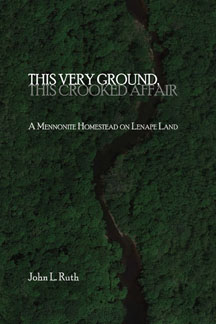|
 |
||||||||
|
|
Cascadia home | ||||||||
|
Reviewing in Anabaptist World Rachel Waltner Goosen says this of John Ruth’s history of the Lenape: "This Very Ground, This Crooked Affair is confessional literature with a driven, critical aim: that those of us benefiting from colonial legacies come to understand the usurping of Indigenous lands as our story. And further, that erasures and omissions of the past do not stand." Summary (also available by PDF flier): Ruth's volume connects the centuries-old history of the author's Pennsylvania Mennonite homestead with that of the land’s indigenous Lenape inhabitants, interweaving documented Pennsylvania history with the national pursuit of a Doctrine of Discovery—and the story of Mennonites who had themselves fled suffering and landlessness with the fates of Native Americans continent-wide. In previous books, such as Maintaining the Right Fellowship: A Narrative Account of Life in the Oldest Mennonite Community in North America (1984) and The Earth is the Lord’s: A Narrative History of the Lancaster Conference, Ruth minimally acknowledged the Indigenous people replaced by his ancestors. In contrast, in This Very Ground, This Crooked Affair he has continued to tell about William Penn, other colonists connected with Penn, and Mennonite immigrant settlers—but this time has placed the Lenapes of the Delaware Valley at the center rather than the margins of the story. "Ruth dares us to remember how the Original People of Turtle Island responded to the English Quakers and Swiss-German Mennonites breaking into their world. How could such strangers learn to live in peace? How can a human being 'own' land? What is justice for all? After a lifetime of unearthing facts, with inspired insight Ruth builds the foundation stories of who and what we are today. Listen to him—very carefully." — Rudy Wiebe, Author, Of This Earth: A Mennonite Boyhood in the Boreal Forest "Mennonites
seeking to settle on Lenape land, on what 'belonged' to William Penn,
held in their bones the deep shatterings of being forced off land they
loved. In Penn's Province they found a new Gottesgarten, a wooded and
streamed paradise. But the garden was not empty. The land was not
vacant. In erudite, short chapters, author John Ruth leads readers to
the fields, woods, cities, and streams where the choices and legacies
of Quaker leader William Penn, Lenape headman Sassoonan, and Mennonite
settlers converge. This book names the Lenape, and, through diligent
research and perhaps some historical imagination, recovers lost voices.
It represents atonement, the attempt of one masterful storyteller to
retell, beg forgiveness, and circle the story once again." — Kimberly D. Schmidt, Director,
Washington Community Scholars' Center; Professor of History, Eastern
Mennonite University Excerpt from the Foreword: "Here, John Ruth, approaching the end of a long life, hears in his head the echoes of the stories he has told, and is dissatisfied with his omissions, the gaps, the acceptance of invisibility. This book is his vow to do better. His deep history is no dutiful, perfunctory, or obliging land acknowledgment, some chastened convert’s newfound understanding of the Doctrine of Discovery and its error of terra nullius—the settler’s fantasy of 'vacant land' or 'uninhabited terrain.' Rather, this history is the working out of Ruth’s lifelong wrestling with his realization that his tiny homestead is an Original People’s homeland. —Raylene Hinz-Penner, Author, Searching for Sacred Ground: The Journey of Chief Lawrence Hart, Mennonite Market: Historians, scholars engaging the historical and contemporary intersections of Native American—especially Lenape—history, anyone interested in the story of “A Mennonite homestead on Lenape land” told by a historian who both lives on that very land and has exhaustively studied how it passed from the Lenape to his ancestors in “a crooked affair.” Shelving: History—Native American, Indigenous peoples, Lenape, Sassoonan, Pennsylvania, William Penn, United States colonial era, Anabaptist, Mennonite; Doctrine of Discovery. BISAC: History—United States/ Indigenous Peoples of the Americas; Religion—Christianity/Mennonite The Author: Author, historian, and documentarian John L. Ruth, Harleysville, Pennsylvania, is recognized for depicting the lives of Mennonites and their spiritual cousins, the Hutterites and the Amish. With family roots in Switzerland, John Landis Ruth was born in 1930 on a farm 29 miles northwest of Philadelphia, Pennsylvania, and ordained a Mennonite minister at age 20. After earning his PhD at Harvard University and teaching English and American literature at Eastern University and Universitšt Hamburg, he turned to film documentaries on the Amish and Hutterites which have appeared on PBS and been featured on “60 Minutes.” Ruth's narratives of Pennsylvania Mennonite life include Maintaining the Right Fellowship: A Narrative Account of Life in the Oldest Mennonite Community in North America (1984), The Earth is the Lord’s: A Narrative History of the Lancaster Conference Mennonites (2001), and Forgiveness: A Legacy of the West Nickel Mines Amish School (3rd. ed. 2010). Quote: Publisher: Cascadia
Publishing House LLC |
|||||||||
|
|
|||||||||




